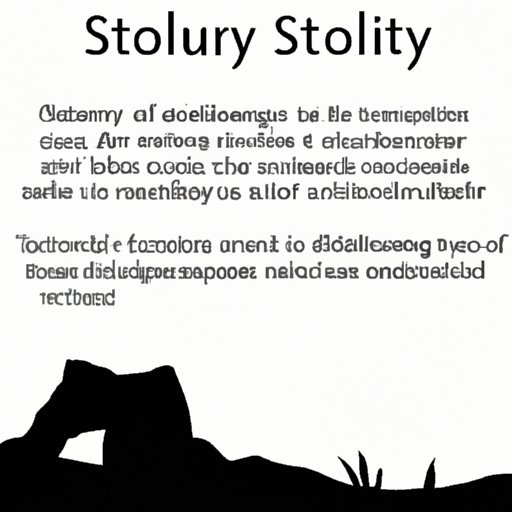Introduction
A soliloquy is a dramatic device in which a character speaks their inner thoughts and feelings out loud while they are alone on stage. It is often used as a tool to reveal key aspects of a character’s nature and to progress the plot of a story. Soliloquies have been used in literature since the time of the Ancient Greeks and remain an important tool in modern storytelling.

Exploring the History of Soliloquy in Literature
The use of soliloquy dates back to Ancient Greek theatre, where it was used to portray the inner thoughts and feelings of characters. In these early performances, actors would recite poems that were written by playwrights and poets such as Sophocles and Euripides. The soliloquies served to provide insight into the characters’ motivations and emotions, and to move the story forward.
Soliloquy continued to be used in literature throughout the centuries. During the Renaissance, William Shakespeare wrote many famous soliloquies for his plays, including “To be, or not to be” from Hamlet. These soliloquies allowed readers to gain a deeper understanding of the characters and their struggles.
In modern literature, soliloquy is still used as a way to explore the inner thoughts and feelings of characters. Writers have developed new ways of using soliloquy to create tension and suspense, as well as to move the story forward.
Examining the Role of Soliloquy in Character Development
One of the primary purposes of soliloquy is to provide insight into the characters’ inner thoughts and feelings. By speaking their thoughts aloud, the audience is able to gain insight into the character’s motivations and emotions. This can help to make them more relatable and sympathetic to the reader.
Soliloquy can also be used to reveal key aspects of a character’s nature. Through a soliloquy, the audience may discover a character’s moral compass, beliefs, and goals. This can help to develop the character and make them more three-dimensional.

Analyzing How Soliloquy Enhances Plot and Theme in Literature
Soliloquy is also used to advance the plot of a story. Through a soliloquy, a character may reveal important information about the story or the events that have taken place. This can help to move the story forward and keep the audience engaged.
Soliloquy can also be used to explore themes in a story. By speaking their thoughts aloud, a character can reveal their own interpretation of a theme or situation. This can help to provide a deeper understanding of the story and its meaning.
Examining Famous Soliloquies Through the Ages
Throughout history, there have been many famous examples of soliloquy in literature. One of the earliest examples is the “Ode to Man” from Sophocles’ play Antigone. In this soliloquy, the character of Antigone reflects on her mortality and her role in society.
William Shakespeare wrote many famous soliloquies during the Renaissance, such as “To be, or not to be” from Hamlet. This soliloquy provides insight into Hamlet’s inner struggles and his contemplation of suicide. It has become one of the most famous soliloquies in literature.
In modern literature, soliloquy continues to be used to explore themes and characters. For example, in J.D. Salinger’s novel The Catcher in the Rye, Holden Caulfield delivers a memorable soliloquy in which he reflects on his life and his place in the world.

Understanding the Power of Soliloquy in Literature
The power of soliloquy lies in its ability to create a sense of emotional connection between the reader and the character. By speaking their thoughts aloud, the character invites the reader into their innermost thoughts and feelings. This can help to create empathy and understanding, allowing the reader to relate to the character.
Soliloquy is also an important tool for writers. By using soliloquy, a writer can provide insight into a character’s motivations and feelings, as well as advancing the plot and exploring themes. It is an effective way to create a powerful and engaging story.
Conclusion
Soliloquy is an important tool in literature, used to explore characters and their inner thoughts and feelings. It can be used to reveal key aspects of a character’s nature, as well as to advance the plot and explore themes. Famous soliloquies from Ancient Greek plays to modern literature demonstrate the power of soliloquy in creating emotional connections and engaging stories.
The use of soliloquy is an essential tool for writers, providing insight into characters and their struggles. By mastering the art of soliloquy, writers can create powerful and engaging stories that resonate with readers.
(Note: Is this article not meeting your expectations? Do you have knowledge or insights to share? Unlock new opportunities and expand your reach by joining our authors team. Click Registration to join us and share your expertise with our readers.)
